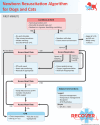RECOVER Guidelines: Newborn Resuscitation in Dogs and Cats. Clinical Guidelines
- PMID: 40847797
- PMCID: PMC12374490
- DOI: 10.1111/vec.70013
RECOVER Guidelines: Newborn Resuscitation in Dogs and Cats. Clinical Guidelines
Abstract
Objective: To present evidence- and consensus-based guidelines for resuscitation of newborn puppies and kittens.
Design: Prioritized clinical questions pertaining to newborn resuscitation and in the Population-Intervention-Comparator-Outcome (PICO) format were used to inform systematic literature searches by information specialists, to extract research findings from relevant publications and synthesize them into evidence, to assess this evidence for quality, and, finally, to develop draft treatment recommendations. These steps were followed by a consensus process and a community commenting period prior to finalization of the project. These RECOVER Newborn Resuscitation Guidelines are a concise summary of the newborn resuscitation process to provide clear and actionable clinical instructions to veterinary professionals.
Setting: Transdisciplinary, international collaboration in university, specialty, and emergency practice.
Results: A total of 28 PICO questions pertaining to resuscitation of puppies and kittens at birth were addressed in this project. This resulted in 59 treatment recommendations that delineate an iterative approach to newborn resuscitation starting with airway clearance, tactile stimulation, and temperature control, as well as positive pressure ventilation, and instruct on more advanced measures such as CPR. An algorithm displays the flow of assessments and actions over the course of the resuscitation process.
Conclusions: These RECOVER Newborn Resuscitation Guidelines present a concise and comprehensive framework for resuscitation of puppies and kittens at birth. These works serve to support veterinary professionals and breeders, educational systems, and research initiatives in conducting, implementing, and advancing newborn resuscitation in puppies and kittens.
Keywords: Cesarean section; birth; cardiopulmonary resuscitation; consensus guidelines; evidence‐based veterinary medicine; neonatal resuscitation.
© 2025 The Author(s). Journal of Veterinary Emergency and Critical Care published by Wiley Periodicals LLC on behalf of Veterinary Emergency and Critical Care Society.
Conflict of interest statement
Dr. Burkitt‐Creedon is the Editor of the Journal but only participated in the peer review process as an author. The authors declare no other conflicts of interest.
Figures





Similar articles
-
RECOVER Guidelines: Newborn Resuscitation in Dogs and Cats. Evidence and Knowledge Gap Analysis With Treatment Recommendations.J Vet Emerg Crit Care (San Antonio). 2025 Aug;35 Suppl 1(Suppl 1):S3-S59. doi: 10.1111/vec.70012. J Vet Emerg Crit Care (San Antonio). 2025. PMID: 40847798 Free PMC article.
-
Prescription of Controlled Substances: Benefits and Risks.2025 Jul 6. In: StatPearls [Internet]. Treasure Island (FL): StatPearls Publishing; 2025 Jan–. 2025 Jul 6. In: StatPearls [Internet]. Treasure Island (FL): StatPearls Publishing; 2025 Jan–. PMID: 30726003 Free Books & Documents.
-
Factors Associated With Return of Spontaneous Circulation and Survival to Hospital Discharge in Dogs and Cats Undergoing Cardiopulmonary Resuscitation Using the Reassessment Campaign on Veterinary Resuscitation (RECOVER) Database.J Vet Emerg Crit Care (San Antonio). 2025 May-Jun;35(3):258-268. doi: 10.1111/vec.13473. Epub 2025 Jun 16. J Vet Emerg Crit Care (San Antonio). 2025. PMID: 40522688
-
Nasal interfaces for neonatal resuscitation.Cochrane Database Syst Rev. 2023 Oct 3;10(10):CD009102. doi: 10.1002/14651858.CD009102.pub2. Cochrane Database Syst Rev. 2023. PMID: 37787113 Free PMC article.
-
2024 RECOVER Guidelines: Updated treatment recommendations for CPR in dogs and cats.J Vet Emerg Crit Care (San Antonio). 2024 Jul-Aug;34 Suppl 1:104-123. doi: 10.1111/vec.13391. J Vet Emerg Crit Care (San Antonio). 2024. PMID: 38924627
References
-
- Katheria A. and Finer N. N., “Newborn Resuscitation,” in Avery's Diseases of the Newborn, 10th ed., ed. Gleason C. A. and Juul S. E. (Elsevier, 2018), 273–288.
-
- Hooper S. B., Kitchen M. J., Polglase G. R., et al., “The Physiology of Neonatal Resuscitation,” Current Opinion in Pediatrics 30, no. 2 (2018): 187–191. - PubMed
-
- Finnemore A. and Groves A., “Physiology of the Fetal and Transitional Circulation,” Seminars in Fetal & Neonatal Medicine 20, no. 4 (2015): 210–216. - PubMed
-
- Wyckoff M. H., Wyllie J., Aziz K., et al., “Neonatal Life Support: 2020 International Consensus on Cardiopulmonary Resuscitation and Emergency Cardiovascular Care Science With Treatment Recommendations,” Circulation 142, no. 16_suppl_1 (2020): S185–S221. - PubMed
-
- Yamada N. K., Szyld E., Strand M. L., et al., “2023 American Heart Association and American Academy of Pediatrics Focused Update on Neonatal Resuscitation: An Update to the American Heart Association Guidelines for Cardiopulmonary Resuscitation and Emergency Cardiovascular Care,” Circulation 149, no. 1 (2024): e157–e166. - PubMed
Publication types
MeSH terms
Grants and funding
LinkOut - more resources
Full Text Sources
Miscellaneous

